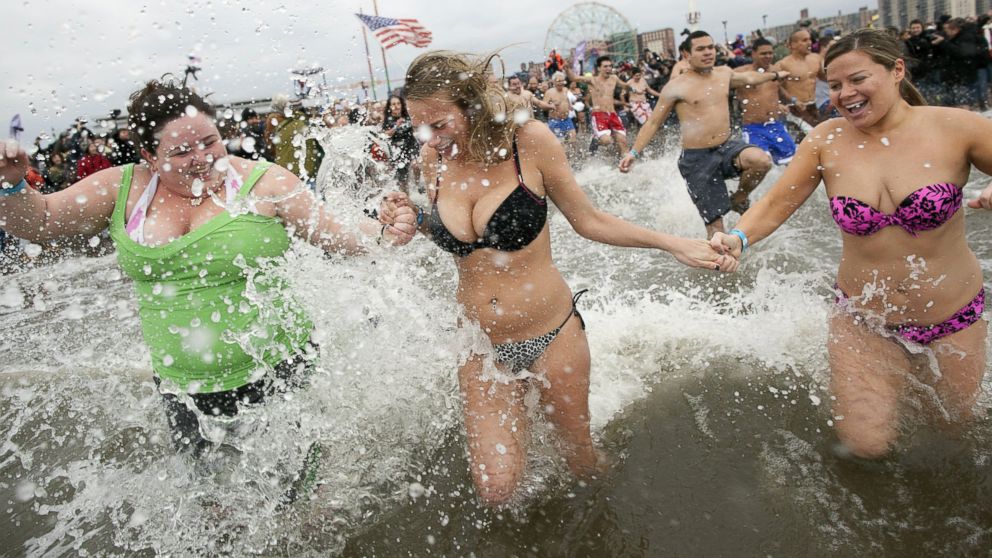What Happens to Your Body During a New Year's Polar Bear Plunge?
New Year's Day polar bear plunges do more than make you shiver.

Dec. 31, 2013— -- intro:Dennis Thomas, 59, was walking along the Coney Island boardwalk 30 winters ago when he spotted two elderly men in bathing suits running into the frigid water.
"I said, 'That's really crazy, and I want to do that,'" said Thomas, who now heads the Coney Island Polar Bear Club, whose 80 to 100 members take a chilly dunk in the Atlantic Ocean every Sunday from November through April.
Check out how people ring in the new year around the world.
On New Year's Day, he expects about 2,500 swimmers to turn up for Coney Island's annual polar bear plunge, which is one of many that will take place around the country.
"Personally, it clears my head," Thomas said. "I will say it's still cold every time. You never get used to it, but you know what to expect."
Click through to learn what happens -- body part by body part -- part during a polar bear plunge.
quicklist: 1 category: Your Body on a Polar Bear Plungetitle:Skinurl:text:First, the cold water chills the skin, which has three to four times as many cold receptors as warm receptors, said Michael Tipton, a physiology professor at the University of Portsmouth in England.
"You get a very, very powerful drive to breathe and an inability to breath-hold," said Tipton, who has completed two polar bear plunges himself.
The hyperventilation combines with a sudden increase in heart rate and blood pressure, but this response typically peaks about 30 seconds after someone enters the water.
"This is really quite potentially one of the most profound physical responses you can initiate," Tipton said, adding that it can be lessened with repeated short exposure to cold water over time.
quicklist: 2 category: Your Body on a Polar Bear Plungetitle:Blood chemistryurl:text:Still, the excessive breathing can change your blood chemistry, said Dr. Thomas Traill, a cardiologist at Johns Hopkins Hospital. Breathing too much can draw carbon dioxide "off" your bloodstream, which changes the pH of your blood and decreases its levels of ionized calcium.
"When ionized calcium goes down, muscle membranes don't function properly," Traill said.
As a result, muscles quickly weaken or can even cause a swimmer to become temporarily paralyzed, he said.
"You hear every now and then of people falling out of boats and drowning in cold water when they're only a foot from the dock," Traill said, attributing this to the uncontrollable hyperventilation. "The important thing for the polar bear swimmers is that they shouldn't do this alone, and they shouldn't do it out of their depth."
quicklist: 3 category: Your Body on a Polar Bear Plungetitle:Musclesurl:text:After the cold reaches your skin, it sinks down into nerves and muscle, potentially causing swimmers to lose their ability to coordinate movements, Tipton said.
A thicker layer of fat, however, can make muscles and nerves less susceptible to the cold.
quicklist: 4 category: Your Body on a Polar Bear Plungetitle:Heart url:text:Polar bear swims are generally safe despite the range of physical responses to the cold water, but inexperienced polar bears could have heart attacks if they already have high blood pressure or another underlying heart condition, because the cold causes a spike in heart rate and blood pressure, Traill said.
quicklist: 5category: Your Body on a Polar Bear Plungetitle:Hypothermia url:text:Given the average adult's body mass, it's unlikely that anyone could die of hyperthermia if they're in the cold water fewer than 30 minutes.
"You read in the press that people died of hypothermia in three or four minutes, but that's just not the case," Tipton said. "People dying in three or four minutes are dying of their cold shock response. They're unable to control their breathing, aspirated water and drowned."
quicklist: 6category: Your Body on a Polar Bear Plungetitle:Safetyurl:text:Thomas said safety is key for the Coney Island Polar Bear Club. Swimmers always enter the water in groups with a lifeguard present, and they never compete.
"There's never any shame on anyone who runs in and runs out," Thomas said.
The club knows its hobby isn't for everyone, and that's OK.
"I tell people if this isn't fun, get the hell out and find something that is," Thomas said.




